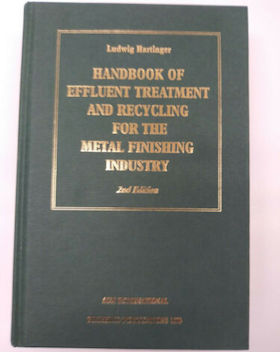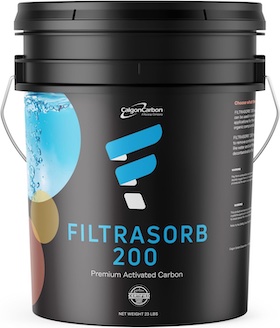
-----
Catalytic oxidation of cyanide with activated carbon
Q. Several articles in the technical literature discuss the possible use of activated carbon, charcoal, etc. to oxidise cyanide in typical plating wastewater streams. This looks like an attractive alternative to traditional alkaline chlorination steps. Does anyone have hands-on experience or information as to its suitability for this purpose?
Maris DislersAdelaide, AUSTRALIA.
1996
A. I've never heard of this and would appreciate hearing from you or other readers about it. It doesn't seem to make sense to me, but I'm probably missing something.

Ted Mooney, P.E.
Striving to live Aloha
finishing.com - Pine Beach, New Jersey
Ted is available for instant help
or longer-term assistance.
A. I'm guessing that the use of activated carbon to destroy cyanide will only work if an oxidizing agent such as hydrogen peroxide is mixed into the waste stream ahead of the carbon. The key is in the title: "catalytic" treatment of cyanide.
Activated carbon will remove some of the cyanide by itself through adsorption, but I doubt there will be any destruction without an oxidizer.

Bill Vins
microwave & cable assemblies - Mesa (what a place-a), Arizona
![]() The articles I have seen are :
The articles I have seen are :
- Oxidation of Cyanides Adsorbed on Granular Activated Carbon
Author: HOFFMAN D C
PLATING Feb. 1973 pp157 to 162
- Decontamination of Cyanide Wastes by Methods of Catalytic Oxidation & Adsorption
Author: BUCKSTEEG, WILHELM
publication unknown.
These suggest that cyanide complexes are adsorbed onto the surface of carbon. However, the carbon also acts as a catalytic surface for oxidation of cyanides with oxygen adsorbed from water or air. In essence, no additional chemicals are needed.
We have performed laboratory scale experiments, where air was bubbled up through a bed of charcoal and static rinse solution from either cyanide zinc or copper plating. Cyanide level dropped from 500-1000 mg/L to virtually zero within 24 hours. A control without charcoal was unaltered. Metals were then precipitated as normal in alkaline conditions. In short, it appeared to have done what is claimed.
Whether this leads to practical application to batch or continuous treatment is now the question.
Hoffman's article refers to the following patents:-
D.G. Hager & J.L. Rizzo, U.S. Patent 3,650,949 (1972)
R.S. Joyce, U.S. Patent 3,222,277 (1965)
J.J. Hronas & J.L.Rizzo, U. S. Patent 3,276,136 (1966)
R.S. Joyse, U.S. Patent 3,192,156 [ed. note: apparently a typo] (1965)
M. Manes & R.J. Grant, U.S. Patent 3,193,987 (1965)
Also, Rejuvenative catalytic oxidation of waste water, particularly for removal of cyanide and sulfur compounds by YAN T. (International Publication Number WO 95/28357) may have some relevance.
It seems that the general process would be public knowledge by now, but I am no expert on matters of Patent.
We are currently setting up a small batch trial using a diffused air supply feeding from the bottom of a 200 liter drum. Charcoal & zinc cyanide waste solution therein. With luck, it will be set up & going for the weekend. I'll give progress report early next week.
I have one concern with this method. We have not tested for toxic headspace gasses, which might be formed. Not much point if the system doesn't work first. I'm not anticipating any problems.
It might be worth waiting for results from trials at two of the plating shops here in Adelaide, before getting anyone else involved.
Hoffman cites two pilot scale installations - an Ohio Automotive parts zinc & copper plater and a New England electrical parts plater. It would be great to track down these people, to learn of their experiences with this treatment.
Adelaide, AUSTRALIA.
A. My dissertation: Adsorption and catalytic oxidation of cyanide on granular activated carbon Skopje 1989
Actual job Separation process: Bentonite Zeolite
Nis Yugoslavia
2001
Q. Dear Sir, I have seen some of your discussions regarding "Catalytic oxidation of cyanide using carbon". Presently I am doing my Ph.D. on this topic. I am working in National Environmental Engineering Research Institute, India. I presume you are using H2O2 as a catalyst for cyanide destruction prior to adsorption on activated carbon? I would like to know about the following facts.
What is role of adsorption when there will be destruction of cyanide due to catalytic oxidation with H2O2?
Whether there will be simultaneous adsorption and destruction of cyanide in the presence of H2O2?
What is role of H2O2 in the adsorption of cyanide onto activated carbon?
Regards
National Environmental Engineering Research Institute - Nagpur, M.S., India
2001
Q. I read with interest the posts concerning the catalytic oxidation of cyanide using carbon. A few informal trials were to be run, but the results were never published in follow-ups. What were the results of the trials?
by Ludwig Hartinger

on eBay
or Amazon
(affil link)
captive plating shop - Rockford, Illinois
2001
A. Hartinger's "Effluent Treatment and Recycling for the Metal Finishing Industry" ⇨ does have a few details on this process and primary references.
Regards
- Lowestoft, U.K.
A. Sir,
The topic is interesting. Activated carbon by virtue of its large surface area may be in a position to offer more reaction sites than otherwise and quicken the process of oxidation either by oxygen or chlorine. I think it should be a circulating stream of carbon particles rather than a fixed bed to improve the efficacy.

Subramanian Ramajayam
consultant - Bangalore, India
|
|
A. Hello I read with interest your paragraphs about using "Activated Charcoal to chelate excess Cyanide. - Fairfield, Connecticut, USA March 14, 2012 |
Q. Is there any more convenient and cost effective method for cyanide removal from waste water.
Piyush kumar srivastava- bubneswar, odisha, India
July 18, 2018
A. Hi Piyush. Please tell us your situation. Alkaline chlorination is widely used. But ozone treatment and electrolytic destruction are sometimes used, and this dialog is about the hope that catalytic oxidation of cyanide using carbon can prove to be a convenient & cost effective method. With luck, someone will update the information on this page with recent promising findings on the subject 🙂
Regards,

Ted Mooney, P.E. RET
Striving to live Aloha
finishing.com - Pine Beach, New Jersey
Ted is available for instant help
or longer-term assistance.
Q, A, or Comment on THIS thread -or- Start a NEW Thread
